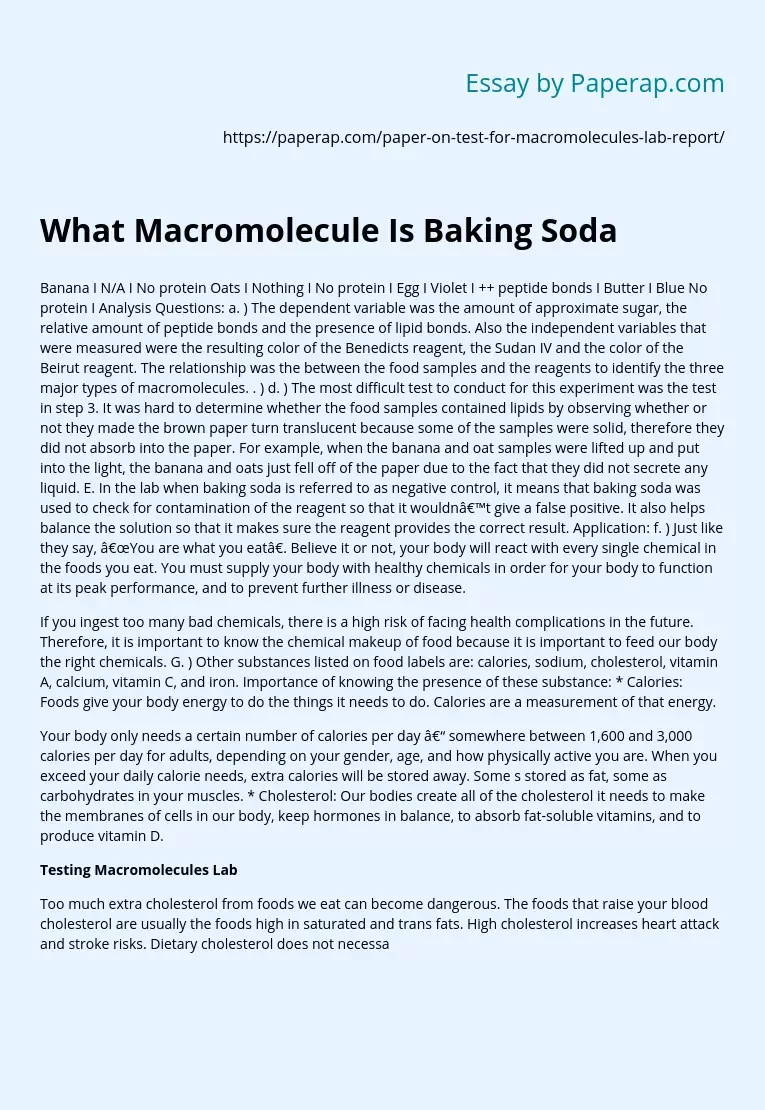Banana I N/A I No protein Oats I Nothing I No protein I Egg I Violet I ++ peptide bonds I Butter I Blue No protein I Analysis Questions: a. ) The dependent variable was the amount of approximate sugar, the relative amount of peptide bonds and the presence of lipid bonds. Also the independent variables that were measured were the resulting color of the Benedicts reagent, the Sudan IV and the color of the Beirut reagent. The relationship was the between the food samples and the reagents to identify the three major types of macromolecules.
. ) d. ) The most difficult test to conduct for this experiment was the test in step 3. It was hard to determine whether the food samples contained lipids by observing whether or not they made the brown paper turn translucent because some of the samples were solid, therefore they did not absorb into the paper. For example, when the banana and oat samples were lifted up and put into the light, the banana and oats just fell off of the paper due to the fact that they did not secrete any liquid.
E. In the lab when baking soda is referred to as negative control, it means that baking soda was used to check for contamination of the reagent so that it wouldn’t give a false positive. It also helps balance the solution so that it makes sure the reagent provides the correct result. Application: f. ) Just like they say, “You are what you eat”. Believe it or not, your body will react with every single chemical in the foods you eat.
You must supply your body with healthy chemicals in order for your body to function at its peak performance, and to prevent further illness or disease.
If you ingest too many bad chemicals, there is a high risk of facing health complications in the future. Therefore, it is important to know the chemical makeup of food because it is important to feed our body the right chemicals. G. ) Other substances listed on food labels are: calories, sodium, cholesterol, vitamin A, calcium, vitamin C, and iron. Importance of knowing the presence of these substance: * Calories: Foods give your body energy to do the things it needs to do. Calories are a measurement of that energy.
Your body only needs a certain number of calories per day – somewhere between 1,600 and 3,000 calories per day for adults, depending on your gender, age, and how physically active you are. When you exceed your daily calorie needs, extra calories will be stored away. Some s stored as fat, some as carbohydrates in your muscles. * Cholesterol: Our bodies create all of the cholesterol it needs to make the membranes of cells in our body, keep hormones in balance, to absorb fat-soluble vitamins, and to produce vitamin D.
Testing Macromolecules Lab
Too much extra cholesterol from foods we eat can become dangerous. The foods that raise your blood cholesterol are usually the foods high in saturated and trans fats. High cholesterol increases heart attack and stroke risks. Dietary cholesterol does not necessarily affect your blood cholesterol level – this depends on the person. Foods low in saturated and trans fats are also low in dietary cholesterol. Doctors do advise to limit dietary cholesterol intake to somewhere between 200 MGM to 300 MGM per day, especially if you are at risk of heart disease. Sodium: Excess levels of sodium in the diet can boost blood pressure to unsafe levels in some people. Aim to eat less than 2,300 MGM (1 teaspoon) of sodium per day, though people in particular risk groups may need to slash sodium to levels as low as 1,500 MGM daily. * Vitamins: Health Canada mandates that food labels include information on a few vitamins and minerals – vitamins A and C, and the minerals calcium and iron. Other nutrients may be noted, especially if a food contains high quantities of a nutrient, a healthy asset that food companies would definitely want to highlight. . ) Butyrate hydroplanes (BAH) is an antioxidant consisting of a mixture of dosimeter organic compounds, 2-term-butyl-4-hydroplanes and 3-term- butyl-4-hydroplanes. It is prepared from 4-methodology and cobblestone. It is a waxy solid used as a food additive with the E number IEEE. The primary use for BAH is as an antioxidant and preservative in food, food packaging, animal feed, cosmetics, rubber, and petroleum products. BAH also is commonly used in medicines, such as jettisoning,alleviation, and sanitation, among others.
BAH has been added to edible fats and fat-containing foods for its antioxidant properties as it prevents food from becoming rancid and developing objectionable odors. BAH side effects means it also cause allergies, affect the brain, alter behavior, and may even cause cancer. BAH is an oxidant which can form cancer-causing compounds in the human body. Butyrate hydroxylation (BATH), also known as photoluminescence, is a allophonic(fat- soluble) organic compound, chemically a derivative of phenol, that is useful or its antioxidant properties.
BATH is advocated as a diet supplement and antiviral useful against herpes family viruses. It is listed for use in foodstuffs like “mixed nuts, margarine, chewing gum” and “enriched rice and frozen breaded shrimp”. Butyrate hydroxylation in food has been observed by the NTP to cause increased liver weight and abnormal cell behavior. Conclusion: Sources of Error: Some experimental issues that occurred during the lab were that things wouldn’t mix properly also the oats and the egg was hard to tell if it was translucent. Other than that everything else went well.
What Macromolecule Is Baking Soda. (2019, Dec 05). Retrieved from https://paperap.com/paper-on-test-for-macromolecules-lab-report/

